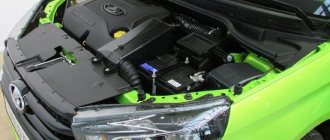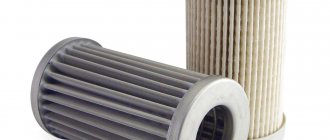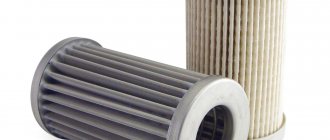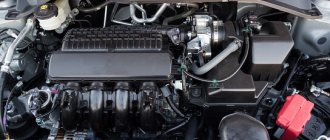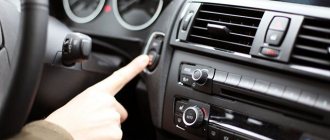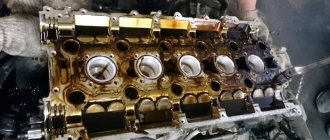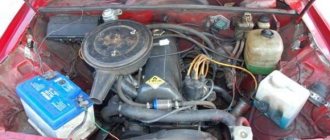Although gas-cylinder equipment combines a number of advantages, the main reason for installing it on a car is the economic side of the issue. Gas costs almost twice as much as gasoline, but due to the increased consumption of liquefied fuel, it is almost impossible to achieve savings of 50%. In addition, one should not miss the fact that the engine starts and warms up using gasoline; The more often the car is used in winter, the higher the cost of gasoline. Due to these circumstances, the question often arises among car owners about how to start a cold engine on gas. It’s worth saying right away that it’s quite possible to implement this, and we’ll tell you the main ways. However, frequent such actions will lead to a number of shortcomings, first of all, this will negatively affect the gearbox.
When to start the engine on gas
Often, the need to start the engine on gas arises due to certain circumstances when breakdowns of the standard fuel system occur, for example, when the fuel pump malfunctions or the injectors are clogged. In addition, the tank may run out of gas, so in order to get to the nearest gas station, you will need to start a cold engine on gas.
However, sometimes the reason for this is the need for total savings. Although it takes a little gasoline to warm up the engine, with frequent starts (especially in winter), you may notice a gradual lowering of the fuel level needle in the tank. To minimize fuel costs, drivers often run the engine on gas.
Starting a gazelle without a key
Some drivers are faced with situations where the key is lost, broken, or the ignition switch itself becomes unusable. For such cases, we have come up with a way to start the Gazelle without a key - with wires. It is advisable not to resort to this method often to avoid serious damage.
Before you begin to “revive” the gazelle, you need to remove (unscrew) the ignition switch. Then perform the following steps.
Effect of gas on the engine
With a correctly installed and configured LPG system, gas fuel only has a positive effect on the engine, increasing its service life. This is due to a number of the following advantages:
- the octane number of gas is higher than that of gasoline, which eliminates the possibility of detonation processes that reduce the life of the CPG;
- the gas does not wash away the oil film that forms on the cylinder walls, so the level of protection of the piston from friction is much higher;
- eliminates the possibility of carbon deposits forming on pistons, exhaust valves and seats;
- The engine oil does not dilute, which has a positive effect on its service life.
However, all these advantages can be obtained only if the LPG is correctly configured, and the peculiarities of its operation should also be taken into account. For example, it is not recommended to drive on gas at high speeds, since liquefied fuel burns slower than gasoline, which leads to an increase in its temperature. The consequence of such driving at high speeds is burnout of the exhaust valves. It is also not recommended to start the engine in cold weather on gas, since this reduces the service life of not only gas equipment parts, but also the internal combustion engine. We will pay special attention to this issue.
Towing a gazelle
The third method is to tow a car with a dead battery. To do this, you will need a third-party car that will drag (tow) the gazelle by the cable until its engine starts. This method is similar to pushing a car, but it is more effective.
Important! Drivers of both vehicles must exercise caution when towing. Braking should be safe for the car in front, and at the same time, the vehicle attached to the cable should not be completely “turned off” when performing a stopping maneuver.
Starting the engine on gas for gas equipment of 2 and 3 generations
We do not recommend using the instructions for starting the engine on gas on an ongoing basis, as this significantly reduces the life of the CPG and the components of gas-cylinder equipment. In this case, the gearbox is most vulnerable. Contact of rubber products with liquefied gas in liquid form helps reduce their service life. Although such components are inexpensive and it is possible to replace them, resorting to frequent engine starts on gas is still harmful for the internal combustion engine, especially if this is done at temperatures below zero.
First, let's look at how to start a gas engine at a temperature above 0 degrees for gas equipment of the 2nd and 3rd generations, where a toggle switch is used to switch. To do this, follow these steps:
- Switch the toggle switch to “Gas” mode.
- Turn on the ignition and fill the mixer with gas.
- Start the engine; As soon as the first signs of its “setting” appear, you need to press the accelerator pedal.
Success depends not only on the correct execution of the above steps, but also on the technical condition of the vehicle. Thus, starting an engine on gas is affected by the level of compression in the cylinders, which should ideally be no lower than 12–14 atmospheres. With this compression, starting the engine on gas will be much easier and faster.
If you resort to frequent engine starts using gas fuel, then you should consider using more modern ignition systems. To do this, a car equipped with a 2nd or 3rd generation gas system (and these are, as a rule, carburetor or injection cars of the budget class) should be equipped with a modern ignition system. This means that it is necessary to install a more powerful ignition coil, modern high-voltage wires and spark plugs. With such equipment, starting the engine on gas will be much easier. However, whether it is worth installing such equipment on a car in order to be able to start the engine from a propane-butane mixture must be decided individually.
Comments 38
Please tell me what to do, my fuel pump doesn’t work, I started turning on the car like in the video with the button, but yesterday I couldn’t start it
, I press and hold when I turn on the ignition the button what remains to be done for our client blinks exactly please tell me
Keep the gas-gasoline switch button pressed and start it
I have a digitronic. To get it on gas, you need to press the gas button and, while pressed, turn on the ignition and start
hold the gas switch button pressed and start the engine
In the summer I tried to start the Dijik, it started easily, alas, later after a certain time the buzzer beeped. I tried to turn it off and start it, the buzzer beeped sickeningly indifferently until I reset the terminal from the acc. Everything returned to the area. Is this also true?
an error on very cool gas could appear in the brain if it was started when it was cool
So when it warms up the buzzer should go silent?
doesn’t work =(the error is already registered in the brain (maybe not the first time, misfires also don’t immediately turn on the CHECK on the dashboard, but only if the car has been running like this for a long time)
so it’s better to start a warm car
.
Clearly, it’s better not to do this at all)
What you need to know about starting a gas engine at subzero temperatures
While it is quite possible to avoid serious problems by starting the engine on gas when the ambient temperature is above 0 degrees, performing such actions in cold weather can result in disappointment. Indeed, in this case, the reducer will simply freeze from the gas, which will lead to the impossibility of its functioning. As a rule, starting the engine in cold weather on gas is quite possible, but the following picture can be seen:
- The motor will start and run for a few seconds.
- After this, it will stall, and subsequent attempts will be useless.
- To successfully start at low temperatures, you will need to first defrost the gearbox. The most rational way in this case is to pour hot water on it.
If you want to save on fuel, then for gas equipment of the 2nd and 3rd generations, start the engine on gas only at an ambient temperature above 10 degrees. When you need to perform an emergency start at low temperatures, preheat the gearbox with hot water, and only then proceed with the process.
"Light up" the car
The second option is to have someone “light” the car by transferring current from one battery to another. In this case, you will need to connect the “lighting” wires using terminals (“crocodile clips”) directly to the “active” and dead car battery. In general, if the question arises about how to properly charge a battery when its charge is low, then this method may come in handy. But when there are no other cars nearby or no one wants to help, it will be problematic to use this emergency start option.
The procedure for starting a gazelle without keys:
- Remember how the wires were inserted.
- Disconnect (disconnect) the negative terminal on the battery.
- Carefully separate the wires. For reliability, it can be additionally insulated.
- Put the car in neutral.
- Place something under the wheels.
- Put the negative terminal back in place.
- It can be difficult to determine which wires to short-circuit in order to start the gazelle by color, since most often instead of the “original” cables you can see insulated “windings”. Therefore, the emphasis is on thick wire. Carefully begin to close (connect) it to other wires (at random).
- The cables are identified by the sound: a click indicates that it belongs to a relay, and a growling sound will indicate that this wire leads to the starter.
As a result, three wires leading to the relay are taken and closed (connected) to each other.
The main wire (negative) is pressed against them. After this, the wire from the starter is pressed against them once.
After simple manipulations, the car should start. To turn off the car, just disconnect the wires.
Such “simple” methods that explain what to do correctly in emergency situations will allow drivers to avoid many unpleasant situations on the road, in the cold or under time pressure.
Exploitation
Refilling a cylinder with liquefied petroleum gas
Refilling a gas cylinder is carried out in strict accordance with the rules of an automobile gas filling station (AGFS).
Under normal operating conditions, the filling and flow valves of the multivalve are in the open position, so the filling process is simplified.
- Brake the car with the parking brake and turn off the ignition;
- connect the fitting of the gas filling station to the filling device, open the gas supply at the gas filling station and perform refueling.
- on the operation of the gas meter at the gas station;
- according to the movement of the arrow of the multivalve level indicator.
Refilling stops automatically when the cylinder is filled with liquefied petroleum gas to 80% by volume, which is controlled by:
- when the gas meter stops working;
- by the characteristic click of the automatic valve and the stop of the movement of the multivalve arrow, which should be approximately in the 4/4 or 1 position.
Overflow is not allowed. If the indicator arrow has gone beyond the 4/4 or 1 position, and there is reason to assume that more than 80% of liquefied petroleum gas by volume is filled into the cylinder, then it is necessary to immediately after filling the gas to the 4/4 or 1 position by moving the car.
Disconnect the gas filling station fitting from the filling device.
For the purpose of refueling safety, strictly adhere to the requirements of the gas station rules, as well as the following:
- do not tighten gas connections under pressure;
- Do not stand near the filling hose while filling the cylinder;
- Do not hit equipment and pipelines under pressure with metal objects.
Do not adjust or repair the gas equipment and do not smoke at the gas station.
To avoid damage to the seals, close the cylinder fill and control valves without using any tools.
When operating a vehicle, it is necessary to present the gas cylinder for inspection to an organization authorized by Gosgortekhnadzor once every two years.
Features of operating a gas-cylinder vehicle
The engine operation is switched from gasoline to gas using the fuel type switch installed on the instrument panel.
The fuel type switch is equipped with a button and a built-in buzzer.
Rice. 9.1. Fuel switch
The button is used to select the type of fuel. One press switches the engine to gasoline, a second press switches the engine to gas mixture.
Green indicator function.
Short flashes - the control unit starts working on gasoline and automatically switches to gas.
Steady signal (yellow indicator is not lit) – operation on gas.
HBO 4 - Alpha M - fine tuning
HBO 4 Alpha M, I decided to bring it to mind and configure it.
What didn’t suit me: 1) failures when pressing the accelerator by 10-40% 2) inflated consumption of 18-24 liters of gas in the city 3) switching from gasoline to gas with a loss of speed up to 375 rpm Back in the fall I ordered a special cable (2500 ₽) and a USB key (another 2500₽) for the Alpha-Tuner program. I installed the cable driver, which by the way is not Proflic, but a tricky serial with only 2 wires. I connected without problems, BUT: I saw different gas equipment from the inside, and for the first time I saw the impossibility of tabular configuration of the fuel map, as for example on the Lovato brains. Management only by setting coefficients. Moreover, what’s interesting is that the auto-calibration mode gives a very good result, better than all sorts of Stag, Barracuda, etc. I had to read the manual before everything broke)
Obvious distinctive features of this brain on the latest firmware: 1) Soft pressurization of the main line - the brain supplies the liquid phase to the gearbox with short activations of the main valve, and the pressure of the vapor phase increases smoothly - without sudden cooling of the gearbox, it saves rubber and injectors. 2) Additional injections of gasoline based on engine load, speed, residual pressure in the tank, and previously unknown Mazda injection: When “asynchronous enrichment” is detected, a temporary switch to gasoline occurs for a time Ta, sec (duration of action of “Mazda injection” , acceptable range is from 0.2 to 2.5 s). This algorithm is only possible with a phased injection type.
3) stabilization of idle speed on gasoline - when the correction at different temperatures is poorly constructed
Please note that on stock OMVL injectors after treatment with Buflon, the minimum injector opening time became shorter than the factory ones; the graph shows that the green (gas) bars are lower than the gray (petrol) bars.
Now, when you press the accelerator smoothly by 5-20%, a smooth increase in speed occurs, because the mixture is not over-enriched, this provides savings with uniform movement, and due to the acceleration coefficient Ka, when you sharply press the accelerator, additional enrichment and good throttle response occur, which ensures convenience in city in the “acceleration-deceleration” mode. In total, this setting significantly optimizes consumption.
After tuning, consumption dropped to 16 liters in the city, stable, 12-15 on the highway, depending on the load of the car.
In general, consumption rose to 20 in the city and 15 on the highway with a full interior stable. I drive 420 km on the highway on 65 liters of gas.
Source
